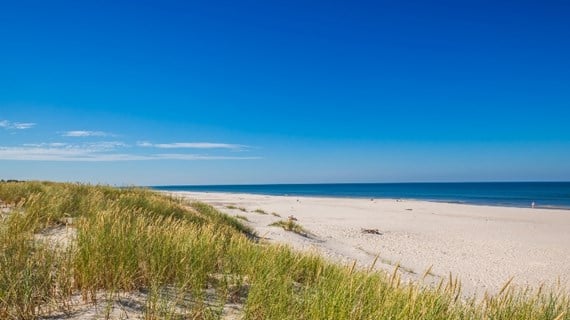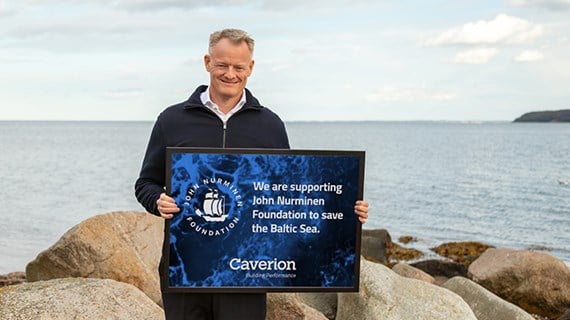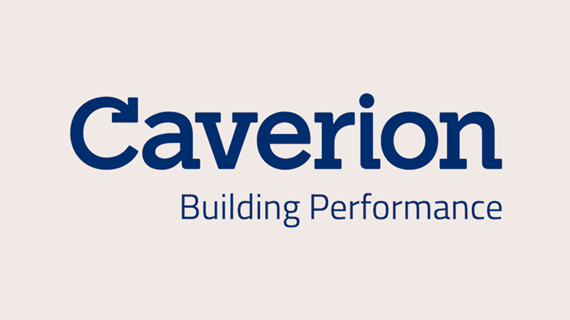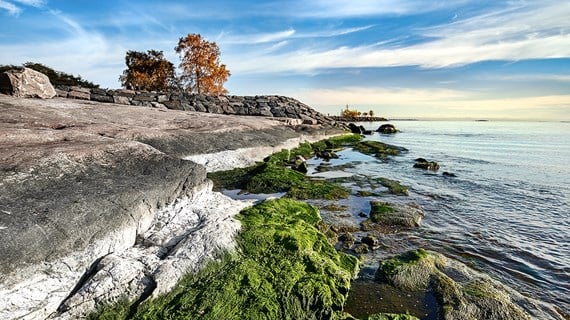Supporting John Nurminen Foundation in their valuable work to save the Baltic Sea
Almost every shore the Baltic Sea touches, is a home to Caverion; in many ways, it is our geographical heart. Unfortunately, it is also one of the most polluted seas in the world. In addition to climate change, the biggest challenge for the Baltic Sea is its eutrophication (the overabundance of algae and plants) caused by phosphorus and other nutrients. The main source of these nutrients is agriculture.
Since 2021, Caverion has been donating to John Nurminen Foundation and supporting their work to save the Baltic Sea and its heritage for future generations.

Photo: Lasse Hendriks | John Nurminen Foundation
Cooperation is crucial in international waters
John Nurminen Foundation (JNF) is based in Finland and focusing not only on concrete actions to conserve the Baltic Sea but also on training, increasing awareness, influencing national and international policy making and coordinating best practices also internationally. As much as 80% of John Nurminen Foundation’s operations is financed with corporate donations, ours being one of them.
“Cooperation is crucial, with donations but also with the surrounding countries since we share the Baltic Sea. Finland has a long coastline and therefore a big responsibility, but we need each other in order to preserve the sea”, says Ulla Rosenström, Marine Environment Director, John Nurminen Foundation.
Concrete actions have led to concrete results
A few examples of recent projects financed by corporate donations are the Manure Recycling Project (2020-2024), the Fertilizer Shipping Project (2020-2024) and the Baltic Sea Grass Project (2023-2026).
- The Manure Recycling Project (2020-2024) in Finland has focused on recycling the phosphorus-rich manure from livestock farms in the Baltic Sea catchment areas to the plant farms in the areas with nutrient deficit. By doing so, they could reduce the amount of nutrients ending up in the Baltic Sea and offer nutrients where they were needed.
“In Finland, agriculture accounts for up to 80% of the phosphorus load ending up in the Baltic Sea. In areas where too much manure is produced, the excess nutrients should be transported to farms that need them.”, Ulla explains. “This year, the project has had 18 farms participating, and we managed to recycle over 8 tons of phosphorus.”
“
10 kilograms of phosphorus is already enough to create 10 tonnes of algae.
- In the Fertilizer Shipping Project (2020-2024) they first identified the root reasons and then piloted solutions for preventing fertilizer particles ending up in the Baltic Sea from maritime transport.
According to the foundation, from a 5000-tonne cargo ship, 2.5 tonnes of fertilizers can end up in the Baltic Sea due to dusting during loading and unloading. If 2.5 tonnes of fertilizers include 5% of phosphorus, it means 125kg phosphorus ending up in the sea. Ten kilograms of phosphorus is already enough to create ten tonnes of algae.
“One way to reduce the fertilizer residue ending up in the sea is to install a plate between the cargo ship and the quay for loading and unloading fertilizers. This was piloted in the Kokkola port in Finland”, says Ulla. “The solutions are fairly simple. Also, installing filters in the stormwater drains in a port and improving cleaning methods and cargo handling will go a long way.” These project findings will create a basis for instructions for handling fertilizers at ports all around the Baltic Sea.

Image: © John Nurminen Foundation
Pink dots: On-going projects | Blue dots: Finished projects | Areas marked with blue: The Baltic Sea catchment area
- In the Baltic Sea Grass project (2023-2026), John Nurminen Foundation together with its partners is planting common eelgrass back in the Baltic Sea in the areas where it has previously grown but has then disappeared. The seabed meadows formed by common eelgrass have several tasks; provide home and food for many species, improve the water quality with its ability to bind nutrients and work as an effective carbon sink, few to mention.
Wish for the built environment
What can we do in the built environment? Ulla has a suggestion: “Stormwater runoff can cause significant harm to rivers, lakes, and coastal waters. In the built environment around the Baltic Sea, we should focus more on managing runoff water sustainably to prevent harmful substances from being washed into the Baltic Sea.”
“If we could retain the runoff water long enough to allow harmful particles to settle before releasing it into stormwater wells”, Ulla ponders, “One approach is to direct runoff water/rainwater into green roofs, for example.” It’s also crucial to recycle construction waste and find innovative ways to use sustainable raw materials, like reed.
This work is done together.

John Nurminen Foundation – Saving the Baltic Sea
Founded in 1992, the purpose of the John Nurminen Foundation is to save the Baltic Sea and its heritage for future generations. The Foundation’s projects improve the status of the Baltic Sea by reducing the nutrient load and environmental problems, such as eutrophication and nature loss, faced by the sea. The Foundation’s tasks also include safeguarding, celebrating and communicating the stories and cultural heritage of the Sea. The work is steered by measurable results and impact. The Foundation’s operations are mainly funded by donations and grants. www.johnnurmisensaatio.fi/en
10 easy ways how you can help the Baltic Sea
According to John Nurminen Foundation, there are 10 easy ways to help conservating the Baltic Sea every day:
- Eat sustainably caught fish. Reduce dairy products and enjoy vegetarian meals.
- Buy less and favour recycling and repairing.
- Prefer walking, cycling and public transportation. Enjoy also your holiday trips close by.
- Avoid unnecessary chemicals and plastics in everyday products. Prefer eco-labelled products.
- Sort your waste correctly and collect trash from the nature – take a trash bag with you for the walk!
- Always take old medicines to the pharmacy and avoid diclofenac pain gels.
- When on the sea, don’t pee in the water and empty the septic tank ashore.
- Choose renewable energy and use it sparingly.
- Choose a composting dry toilet for your cottage.
- Inspire others to do so too and spread the word.



